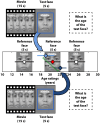Illusion of visual stability through active perceptual serial dependence
- PMID: 35020432
- PMCID: PMC11580026
- DOI: 10.1126/sciadv.abk2480
Illusion of visual stability through active perceptual serial dependence
Abstract
Despite a noisy and ever-changing visual world, our perceptual experience seems remarkably stable over time. How does our visual system achieve this apparent stability? Here, we introduce a previously unknown visual illusion that shows direct evidence for an online mechanism continuously smoothing our percepts over time. As a result, a continuously seen physically changing object can be misperceived as unchanging. We find that online object appearance is captured by past visual experience up to 15 seconds ago. We propose that, because of an underlying active mechanism of serial dependence, the representation of the object is continuously merged over time, and the consequence is an illusory stability in which object appearance is biased toward the past. Our results provide a direct demonstration of the link between serial dependence in visual representations and perceived visual stability in everyday life.
Figures




References
-
- I. Al-Haytham, The optics of Ibn Al-Haytham (AI Sabra, Trans.) (Warburg Institute, 1083).
-
- H. Von Helmholtz, Handbuch der Physiologischen Optik [Handbook of physiological optics] (Voss, 1866).
-
- Simons D. J., Chabris C. F., Gorillas in our midst: Sustained inattentional blindness for dynamic events. Perception 28, 1059–1074 (1999). - PubMed
-
- Simons D. J., Rensink R. A., Change blindness: Past, present, and future. Trends Cogn. Sci. 9, 16–20 (2005). - PubMed
-
- Rensink R. A., Change detection. Annu. Rev. Psychol. 53, 245–277 (2002). - PubMed
Grants and funding
LinkOut - more resources
Full Text Sources
Research Materials
Miscellaneous

